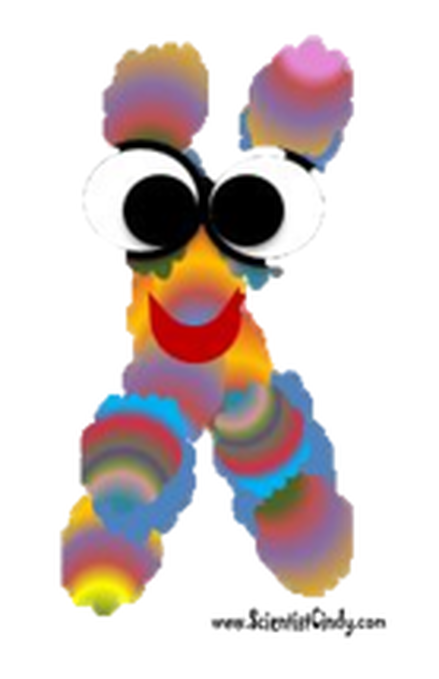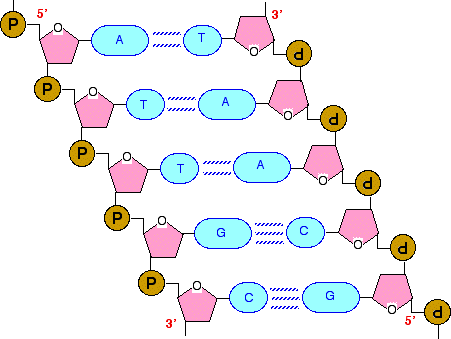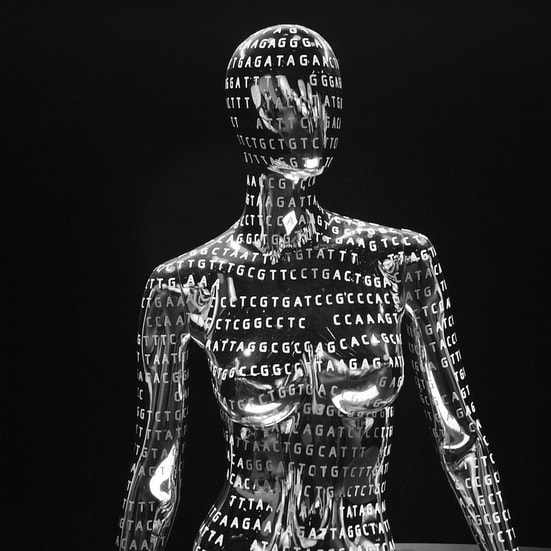STRUCTURE OF NUCLEIC ACIDS

So, what is the big deal with DNA? What does it do?
DNA has 2 functions.
DNA has 2 functions.
- Autocatalytic Function - It Directs its Own Synthesis
- Heterocatalytic Function - It Directs the Synthesis of RNA and Proteins
|
Nucleic acids are the building blocks for DNA and RNA in living organisms. An individual nucleic acid is composed of the following:
|
An Illustration of the DNA Sugar-Phosphate Backbone In a molecule of DNA or RNA, individual nucleotides are linked together to make a sugar-phosphate backbone. The backbone of DNA is made up of alternating deoxyribose sugar molecules and phosphate molecules.
There are only 4 nitrogenous bases found in DNA
There are only 4 nitrogenous bases found in DNA
- Adenine (A)
- Guanine (G)
- Cytosine (C)
- Thymine (T)
DNA is double stranded. Each strand of DNA is connected to the other DNA strand though hydrogen bonding. This hydrogen bonding occurs between the nitrogenous bases on opposite DNA strands.
- A can only pair with T using 2 hydrogen bonds
- C can only pair with G using 3 hydrogen bonds
Hydrogen bonds are relatively weak. It is important for the hydrogen bonds to be able to be broken when the cell needs access to the individual DNA strands. For example, the two DNA strands need to be separated for DNA replication during reproduction and to make the mRNA template during transcription.
THE CENTRAL DOGMA OF MOLECULAR BIOLOGY
The central dogma of molecular biology explains how the information encoded in DNA sequences (genes) is expressed as proteins in a two-step process: Step One) Transcription and Step Two) Translation. Transcription involves making mRNA using DNA as a template. Translation then translates the mRNA sequence into an amino acid sequence to form a protein.
The DNA strands are oriented anti-parallel to one another. The ends of the DNA molecule are different. One end of the DNA molecule is designated 3' (stated as 3 prime) and the other as 5' (stated as 5 prime). They are named according to the how the carbon atoms are numbered in the ribose sugar molecule of the DNA backbone. In a molecule of DNA, one strand will be oriented from 3' to 5', and the other from 5' to 3'.
All Living Organisms Use
DNA as Their Genetic Material.
DNA as Their Genetic Material.

By Eukaryote_DNA.svg: *Difference_DNA_RNA-EN.svg: *Difference_DNA_RNA-DE.svg: Sponk (talk)translation: Sponk (talk)Chromosome.svg: *derivative work: Tryphon (talk)Chromosome-upright.png: Original version: Magnus Manske, this version with upright chromosome: User:Dietzel65Animal_cell_structure_en.svg: LadyofHats (Mariana Ruiz)derivative work: Radio89derivative work: Radio89 - This file was derived from Eukaryote DNA.svg:, CC BY-SA 3.0, https://commons.wikimedia.org/w/index.php?curid=20539140
The DNA of humans is packaged into 2 sets of 23 distinct chromosomes. One set is from your mom and the other is from your dad.
Genetic Variance
Genetic variance is brought about by 1) crossing over and 2) independent assortment. Even though we all have the same genes, the type of genes are different. You can think of it as having different flavors of ice cream. Ice cream has a lot of different flavors, but they are still ice cream. In genetics, we call the different types of genes, Alleles. The form of the gene can be either DOMINANT or RECESSIVE. A dominant gene is the one that can mask the expression of the a recessive gene. Humans have 2 full sets of chromosomes.
One set of your chromosomes comes from your mom that came from the egg that made you, and the other set came from your dad in his sperm that fertilized the egg. So you have 2 sets of 23 chromosomes, for a total of 46 chromosomes. Since you have 2 full sets of chromosomes, this means that you have 2 genes for each of your traits (one gene from mom and one gene from dad). Some genetic traits are dominant and will be expressed (outwardly displayed), even if the other equivalent gene is a recessive form. A recessive gene is the gene that can be masked by the dominant gene.
A phenotype is the observable characteristics or traits that are displayed in an organism according to their genotype. A phenotype is the result of a person's genotype. A genotype is the actual genes the organism carries. Though phenotype and genotype are related, they are not the same thing. Let's look at why!
An Example of the Benefits of Genetic Diversity
Read more at the link above which will bring you to the URL https://www.geneticliteracyproject.org/2014/04/04/black-plagues-quirky-genetics-700-years-later/

Meiosis increases genetic variation due to the random recombination of genetic material (from mom and dad). It is for this reason that we consider meiosis sexual reproduction. Asexual reproduction, like we see in mitosis, yields genetically identical offspring (clones of the parent cell). Sexual reproduction is important for survival of the species. For example, when a potentially detrimental change occurs in the environment, a species having a wide variety of genetic variation will have a much better chance that at least some of the individuals of the species will survive.
A very significant example of this in human history is the Black Plague (a.k.a. The black Death) that took the lives of approximately one-half of Europe's population in the 1300's.
When viruses invade the body, they do not have the ability to reproduce on their own. They must invade the hosts's cells and then hijack the reproductive machinery of the cell to produce more copies of the virus. Then the copies of the virus cause the host cell to burst open, freeing thousand of copies of the virus that can then continue the cycle of cell invasion and virus replication. Eventually, as the amount of the virus increases in the body, the victim will become ill and display the symptoms of the illness.
In order for viruses to invade the host cells in the first place, the host cell must carry specific receptor that has the complementary shape to the virus. You can think if the receptor as a LOCK and the virus as the KEY. If the virus doesn't fit, it cannot "open the door" and gain entrance to the host cell. In the case of the Black Plague, some of the European population carried a specific type of genetic mutation that caused the receptor that the virus uses to gain access to the cell, to be misshapen! The virus was unable to invade the cells of these individuals, so the virus could not reproduce and make these people sick. The mutation gave them immunity to the virus! A similar story can be found more recently in the discovery of the Delta 32 mutation that allowed some people to be immune to the HIV virus! More interestingly, this mutation (Delta 32) prevents both HIV and plague bacteria from entering human cells and causing infection.
Genetic diversity allows offspring to have a better chance of surviving environmental changes (natural selection). This diversity comes about through the process of Meiosis which creates eggs (oocytes) and sperm (spermatozoa). Your eggs and sperm cells are sex cells and they have a special name, GAMETES. Your gametes develop from a progenitor cell. The Progenitor cell will enter the cell cycle. At the beginning of G1, the progenitor cell has 46 chromosomes (23 chromosomes from the mom and 23 chromosomes from dad). In S-Phase, the chromosomes of the cell replicate them selves, but the copies stay attached to each other at the centromere. The genetic material is doubled, but the chromosome number has not changed. The chromosomes are in a de-condensed state here and are also called chromatin in this form. Also, the chromosomes are not visible in this state. Next, the cell undergoes the G2 phase in final preparation for Meiosis.
A very significant example of this in human history is the Black Plague (a.k.a. The black Death) that took the lives of approximately one-half of Europe's population in the 1300's.
When viruses invade the body, they do not have the ability to reproduce on their own. They must invade the hosts's cells and then hijack the reproductive machinery of the cell to produce more copies of the virus. Then the copies of the virus cause the host cell to burst open, freeing thousand of copies of the virus that can then continue the cycle of cell invasion and virus replication. Eventually, as the amount of the virus increases in the body, the victim will become ill and display the symptoms of the illness.
In order for viruses to invade the host cells in the first place, the host cell must carry specific receptor that has the complementary shape to the virus. You can think if the receptor as a LOCK and the virus as the KEY. If the virus doesn't fit, it cannot "open the door" and gain entrance to the host cell. In the case of the Black Plague, some of the European population carried a specific type of genetic mutation that caused the receptor that the virus uses to gain access to the cell, to be misshapen! The virus was unable to invade the cells of these individuals, so the virus could not reproduce and make these people sick. The mutation gave them immunity to the virus! A similar story can be found more recently in the discovery of the Delta 32 mutation that allowed some people to be immune to the HIV virus! More interestingly, this mutation (Delta 32) prevents both HIV and plague bacteria from entering human cells and causing infection.
Genetic diversity allows offspring to have a better chance of surviving environmental changes (natural selection). This diversity comes about through the process of Meiosis which creates eggs (oocytes) and sperm (spermatozoa). Your eggs and sperm cells are sex cells and they have a special name, GAMETES. Your gametes develop from a progenitor cell. The Progenitor cell will enter the cell cycle. At the beginning of G1, the progenitor cell has 46 chromosomes (23 chromosomes from the mom and 23 chromosomes from dad). In S-Phase, the chromosomes of the cell replicate them selves, but the copies stay attached to each other at the centromere. The genetic material is doubled, but the chromosome number has not changed. The chromosomes are in a de-condensed state here and are also called chromatin in this form. Also, the chromosomes are not visible in this state. Next, the cell undergoes the G2 phase in final preparation for Meiosis.
Genetic Inheritance
|
Genetic variance is brought about by 1) crossing over and 2) independent assortment. Even though we all have the same genes, the type of genes are different. You can think of it as having different flavors of ice cream. Ice cream has a lot of different flavors, but they are still ice cream. In genetics, we call the different types of genes, Alleles. The form of the gene can be either DOMINANT or RECESSIVE. A dominant gene is the one that can mask the expression of the a recessive gene. Humans have 2 full sets of chromosomes. One set from your mom that came from the egg that made you, and one set came from the sperm that fertilized the egg. So you have 2 sets of 23 chromosomes, for a total of 46 chromosomes. SInce you have 2 full sets of chromosomes, this means that you have 2 genes for each of your traits (one gene from mom and one gene from dad). Some genetic traits are dominant and will be expressed (outwardly displayed), even if the other equivalent gene is a recessive form.
An individual would have to be homozygous recessive in order to have the recessive trait. This means that they have inherited a recessive gene from mom and a recessive gene from dad. The notation that geneticists use to denote a homozygous recessive genotype is by using 2 lower-cased letters. The letter can be anything, but we usually try to have the letter 'mean' something. Forexample, if we wish to designate the letter 'E' for eye color, then the dominant eye color of brown will be symbolized as 'E' and the recessive trait of blue eyes will be symbolized as 'e'. The genotype of an individual that is homozygous recessive for eye color would be 'ee'. A homozygous dominant individual would be 'EE'. A person that is heterozygous for eye color would be "Ee" and would have inherited a dominant gene for eye color from one parent and a recessive gene for eye color from the other parent. This individual would have brown eyes, since the dominant allele will mask the recessive allele. Genotype- the actual allele combination in an individual Phenotype- outward manifestation or expression of an individuals genotype Alleles- alternative forms of the same gene Dominant is the one that can mask the expression of the other Recessive the gene whose expression is able to be masked Homozygous recessive-
|










